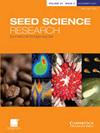种子含水量和贮藏环境缺氧条件下水稻种子寿命的研究
IF 1.9
3区 生物学
Q2 PLANT SCIENCES
引用次数: 0
摘要
储存过程中细胞大分子的累积氧化降低了种子的寿命。本研究旨在揭示水稻种子在储存过程中导致退化的生理和生化变化。将保持在三种不同种子水分含量(SMC;10%、12%和14%)的水稻种子储存在气密玻璃罐中。一半的罐子用氮气冲洗以提供改良的氧气条件,而另一半用天然空气(21%O2)密封。在25°C下储存3个月和6个月后,监测种子发芽和抗氧化防御机制方面的质量。结果表明,种子在低SMC(10%和12%)下储存时表现更好,而在高SMC(14%)下储存则加速了退化过程。高SMC与储存环境中氧气的可用性相结合对种子质量和寿命产生了负面影响。抗氧化剂分析的结果显示,与在改良的氧气条件下储存的较低SMC相比,在高SMC(14%)下储存的含氧种子具有更高的活性。因此,建议在低水分(12%)或更低水分(10%)的条件下储存是保持水稻种子质量的最佳条件。然而,在较高的水分水平(14%)下,储存中的氧气对种子寿命和质量的危害更大。本文章由计算机程序翻译,如有差异,请以英文原文为准。
Rice seed longevity in the context of seed moisture contents and hypoxic conditions in the storage environment
Cumulative oxidation of cellular macromolecules during storage reduces seed longevity. This study was undertaken to unravel the physiological and biochemical changes in rice seeds that contribute to deterioration during storage. Rice seeds maintained at three different seed moisture contents (SMC; 10, 12 and 14%) were stored in airtight glass jars. Half of the jars were flushed with nitrogen gas to provide modified oxygen conditions, while the other half were sealed with natural air (21% O2). Seed quality in terms of germination and antioxidant defence mechanisms was monitored after 3 and 6 months of storage at 25°C. The results showed that seeds performed better when stored at low SMC (10 and 12%), whereas the deterioration process accelerated in seeds stored at higher SMC (14%). Coupling high SMC with the availability of oxygen in the storage environment produced a negative effect on seed quality and longevity. Results from the antioxidant analysis showed more activity in seeds stored with oxygen at high SMC (14%) compared to lower SMC stored in modified oxygen conditions. Therefore, it is recommended that storage with low moisture levels (12%) or below (10%) is the best to preserve rice seed quality. However, at higher moisture levels (14%), the availability of oxygen in storage is more harmful to seed lifespan and quality.
求助全文
通过发布文献求助,成功后即可免费获取论文全文。
去求助
来源期刊

Seed Science Research
生物-植物科学
CiteScore
3.60
自引率
4.80%
发文量
23
审稿时长
>12 weeks
期刊介绍:
Seed Science Research, the official journal of the International Society for Seed Science, is a leading international journal featuring high-quality original papers and review articles on the fundamental aspects of seed science, reviewed by internationally distinguished editors. The emphasis is on the physiology, biochemistry, molecular biology and ecology of seeds.
 求助内容:
求助内容: 应助结果提醒方式:
应助结果提醒方式:


